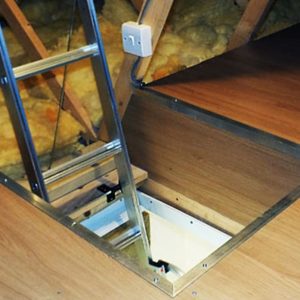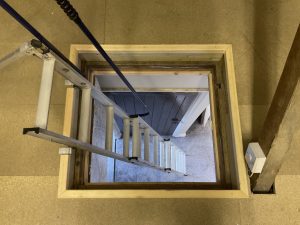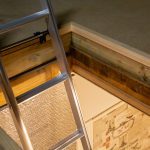Have you ever accessed your loft by climbing on an unsteady stepladder (or, worse, standing on a chair) and hauling yourself up? It’s not only dangerous, it’s also ridiculously difficult. With a fitted loft ladder, on the other hand, you can climb straight up easily and safely.
It makes sense to have a loft ladder, but what should you be looking for?
Types of Loft Ladder
There are four common types of loft ladders. It’s largely a matter of taste, although the space available may influence your choice.
- The sliding loft ladder, usually separate from the hatch and pulled down with a metal pole, is the most straightforward type. It’s easy to install and climb but takes up more space in the loft.
- The folding loft ladder is integrated with the hatch. It takes up minimal space in the loft when stowed away, though it needs more clearance than other types to open.
- The concertina loft ladder folds neatly upwards and, like the folding ladder, takes up very little space. Its pitch can be adjusted, so it’s ideal when there’s little clearance below the hatch.
- The telescopic loft ladder, as its name suggests, opens telescopically, making its stowed position even more compact than the folding or sliding
Making Sure of the Space
When planning your loft ladder, it’s vital to take accurate measurements, or you could end up with a ladder that doesn’t fit.
The height you measure depends on the type of ladder. For a sliding, concertina or telescopic model, you should measure from the floor the ladder will rest on to the loft floor. For a folding type, measure the floor the ladder rests on to the ceiling in which the hatch opens.
You need to measure the clearance both in the loft and below it. For the loft space clearance, measure the distance both vertically and horizontally from the hinged side of the hatch to the nearest obstacle, whether that’s a rafter, a water tank or a structural timber brace. The clearance below the hatch should be measure along the floor from directly below the hinged side of the hatch to the nearest obstruction.
Don’t forget to measure the size of your hatch as this can also dictate which ladder type will suit. This can be extended, but it’s easier to get the right size to start with.
Confused about measurements? download our handy loft ladder measurement form.
Installing your ladder
Installing a loft ladder, even the sliding type, isn’t a job for an amateur DIYer. Unless your skills are up to professional standard, you’re better off having it done by experts, unless you want to risk a disaster.
If you need to know more about loft ladders check our loft ladder guide.
Ready to talk to us about getting a loft ladder installed? Great, we’d love to help!
Find out more about our Professional Loft Ladder Service or…
Book a Free Survey Today
Was this post useful? Here are some other’s you might like...








